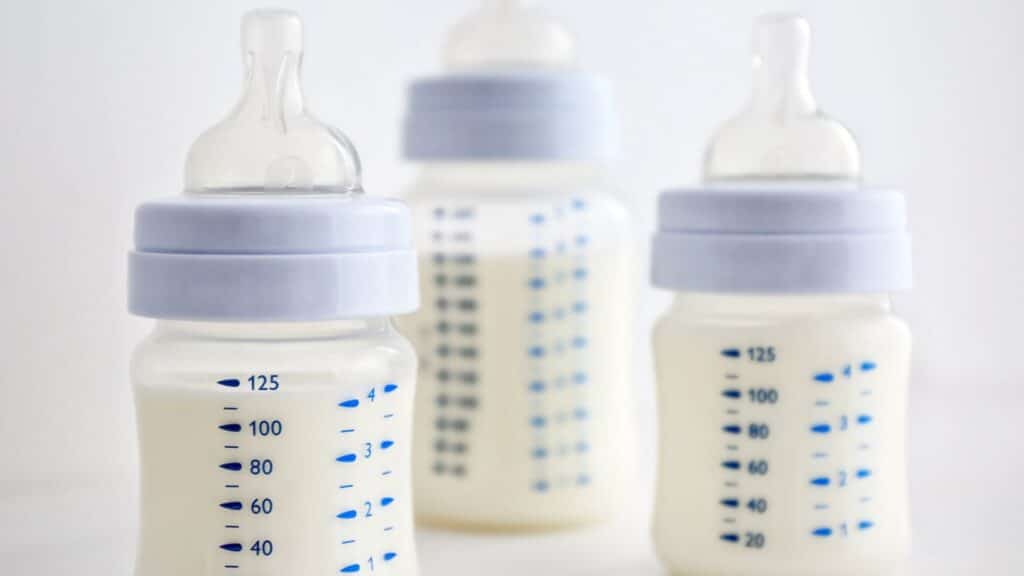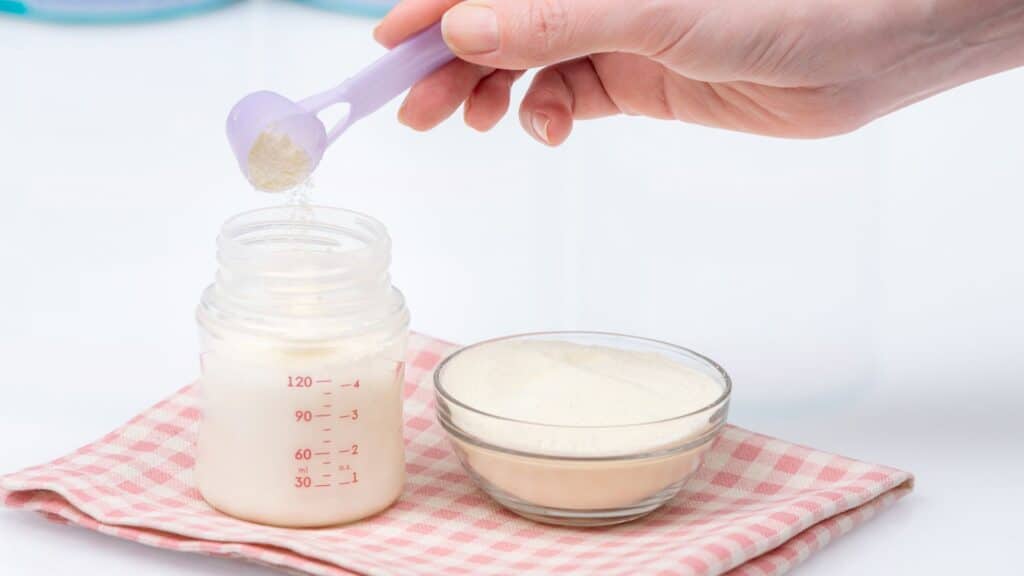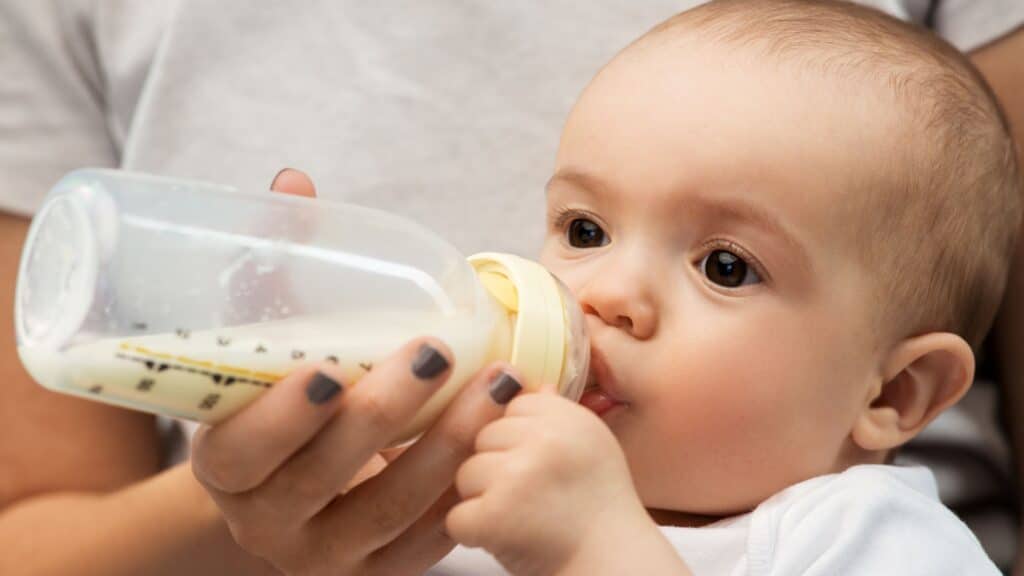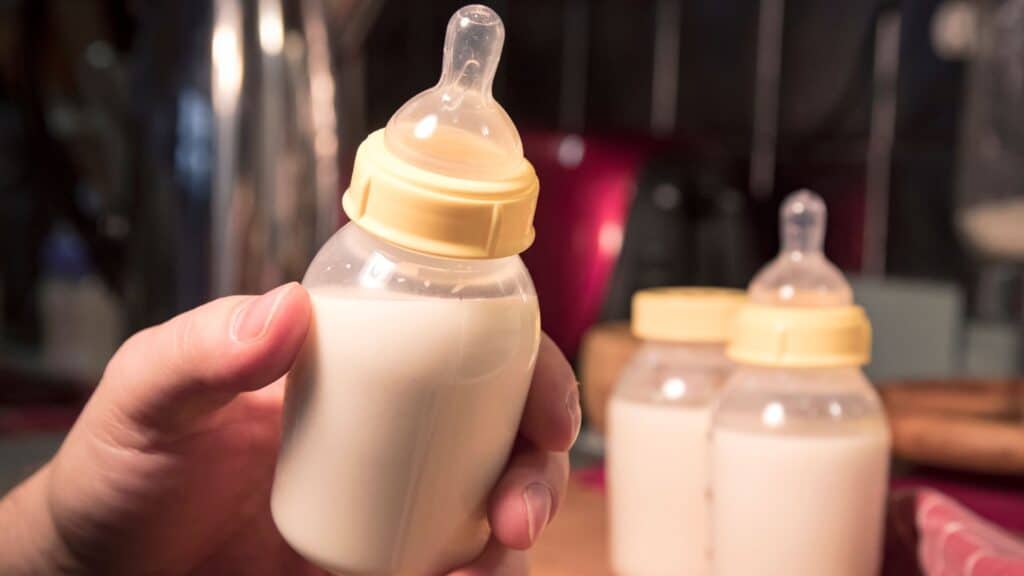As parents, we always strive to provide our little ones with the best care and nutrition, including preparing their baby formula correctly.
While mixing baby formula in advance might seem like a convenient time-saver, it can come with potential risks if not handled properly.
In this blog post, we’ll explore the dangers of bacterial growth in baby formula mixed with water and left at room temperature, the types of bacteria that can pose health risks to infants, and the importance of proper storage and handling.
Additionally, we’ll discuss some alternative feeding options to ensure your baby receives the proper nutrition without compromising safety.
By being aware of these risks and taking necessary precautions, you can help protect your infant from potential health hazards while maintaining a convenient feeding routine.

The Risks of Bacterial Growth in Baby Formula
When preparing infant formula, it’s crucial to be aware of bacteria, as these microorganisms thrive in various environments, including those with moisture and nutrients. When mixed with water, the baby formula creates a suitable environment for growing bacteria, especially when left at room temperature for extended periods. It provides an ideal environment for bacterial growth due to ample nutrients, moisture, and favorable temperatures.
Incorporating disease control measures is crucial to prevent the spread of harmful bacteria. At room temperature, bacteria can multiply rapidly, doubling their population in as little as 20 minutes. As the bacterial population increases, the risk of contamination and potential health hazards for infants also rises. Implementing proper hygiene practices and effective disease control strategies can significantly reduce the risk of illness and ensure a safer environment for everyone, especially vulnerable populations like infants.
Types of Bacteria and Health Risks:
Cronobacter Sakazakii: This bacterium is commonly found in powdered infant formula and poses a significant health risk to infants, particularly newborns and premature babies. Ingesting formula powder contaminated with Cronobacter sakazakii can cause severe infections, including meningitis, sepsis, and necrotizing enterocolitis. These illnesses can result in long-term neurological damage or even prove fatal.
Salmonella: Another type of bacteria that can grow in baby formula is Salmonella. Salmonella infection, or salmonellosis, can cause symptoms such as diarrhea, vomiting, fever, and abdominal cramps. Infants are more susceptible to severe dehydration and complications due to immature immune systems. To avoid these issues, it’s crucial to follow the mix formula instructions carefully and maintain proper hygiene while handling baby formula.
Escherichia Coli (E. Coli): E. coli is a common bacterium that can contaminate a bottle of formula when mixed with contaminated water or if the formula is not stored properly. Some E. coli can cause severe diarrhea, dehydration, and infant kidney failure.
Listeria Monocytogenes: Although less common, Listeria can also contaminate baby formula. Listeriosis can cause flu-like symptoms in infants and, in severe cases, lead to meningitis or sepsis.
Prevention Measures:
To minimize the risks of bacterial growth, following the proper infant formula preparation, storage, and handling guidelines is essential. These include:
- Wash your hands thoroughly before preparing the formula.
- Using safe water sources to mix with the formula.
- Preparing only the necessary formula for each feeding, avoiding large batches.
- Storing prepared formula in the refrigerator and using it within 24 hours.
- Discarding any leftover formula after each feeding, as bacteria from the baby’s saliva can contaminate it.
By following these guidelines and being aware of the risks associated with bacterial growth in baby formula, parents and caregivers can take the necessary steps to protect infants, especially those with weakened immune system, from potential health hazards.

The Importance of Proper Storage of Baby Formula
Proper storage of baby formula is crucial for maintaining its nutritional value and ensuring your child’s safety and health. Bacterial growth can be a significant concern regarding baby formula; appropriate storage practices can help prevent this issue.
Bacterial growth in baby formula can lead to various health problems, including diarrhea, vomiting, and even severe infections in some cases. By storing baby formula correctly, you can minimize the risk of bacterial contamination and provide a safe and nutritious meal for your little one.
Here are some essential tips for storing mixed baby formula:
Refrigerate Immediately:
After preparing formula, it is vital to refrigerate it within one hour. This helps slow bacterial growth, keeping your baby’s formula safe and fresh. Store the formula in the back of the refrigerator, where the temperature is most consistent, at or below 40°F (4°C).
Use Airtight Containers:
Store the mixed formula in clean, airtight containers. This prevents cross-contamination from other foods in the refrigerator and keeps the powder formula fresh. Glass or BPA-free plastic containers with tight-fitting lids are ideal.
Label and Date the Containers:
Label the containers with the date it was prepared to keep track of the formula’s freshness. This will help you ensure you use the formula within the recommended time frame.
Discard Leftover Formula:
Discarding any leftover formula that has been in contact with your baby’s saliva after feeding is crucial, as bacteria from the baby’s mouth can contaminate the formula. Do not store or reuse leftover formula from the bottle.
Follow the 24-Hour Rule:
As a general guideline, the mixed formula should be used within 24 hours of preparation. If the formula has been stored in the refrigerator for more than 24 hours, it’s best to discard it to ensure your baby’s safety.
Avoid Freezing Mixed Formula:
Freezing mixed formula, on the other hand, is not recommended, as it can cause the formula’s texture and nutritional content to change, making it less effective and potentially harmful to your baby. Stick to refrigeration for short-term storage to maintain the formula’s quality and safety. Combining hot water with breast milk can aid in dissolving powdered formula, but it is crucial to monitor the temperature to avoid overheating, which could destroy essential nutrients.

Reheat safely:
When using the refrigerated formula, warm it up using a bottle warmer or by placing the bottle in a container of warm water. Never use a microwave, as it can create hot spots that may burn your baby’s mouth. It’s important to avoid using cold running water, as this won’t effectively heat the formula. Instead, aim for a temperature close to body temperature, as this is ideal for your baby.
By following these guidelines for storing mixed baby formula, you can significantly reduce the risk of bacterial growth and ensure a safe and healthy feeding experience for your child.
Alternatives to Mixing Baby Formula in Advance
There are several alternatives to ensure your baby receives proper nutrition with less hassle.
Here are the three alternatives to mixing formula in advance:
Pre-measured Packets
Pros:
- Pre-measured packets contain a specific amount of powdered formula ready to mix with water. This eliminates the need for measuring and ensures your baby receives the correct nutrients.
- These packets are convenient for on-the-go situations, such as traveling or running errands, since they are easy to carry and require minimal prep time.
- Pre-measured packets reduce the risk of contamination and spoilage since each packet is individually sealed.
Cons:
- The cost per serving may be higher compared to purchasing the formula in bulk.
- Some parents may find it challenging to find pre-measured packets that match their preferred formula brand or type.
- Pre-measured packets can generate more packaging waste compared to using a larger container of powdered formula.
Ready-to-Feed Formula
Pros:
The ready-to-feed formula requires no mixing, making it a convenient option for busy parents or late-night feedings.
- This type of formula is less likely to be prepared incorrectly, as it is already mixed to provide the right balance of nutrients.
- The ready-to-feed formula is often recommended for newborns or premature babies because it reduces the risk of contamination.
Cons:
- The ready-to-feed formula tends to be more expensive than powdered options.
- Once opened, these formulas have a shorter shelf-life and must be consumed within 24-48 hours, depending on the brand.
- The larger containers can be bulky and may not be suitable for travel or on-the-go situations.

Formula Dispensers
Pros:
- Formula dispensers allow parents to pre-measure powdered formula and store it in separate compartments, making it easy to mix with water when it’s time for a feeding.
- These dispensers help reduce the risk of contamination and spoilage by keeping the powdered formula separate from water until needed.
- Formula dispensers are compact and portable, making them great for traveling or on-the-go feedings.
Cons:
- Parents still need to mix the formula with water, which may be inconvenient in certain situations.
- Some dispensers may not have enough compartments for a full day’s worth of feedings, requiring parents to refill the dispenser throughout the day.
- Formula dispensers can vary in size and quality, so parents may need to search for one that best suits their needs and preferences.
Pre-measured packets, ready-to-feed formula, and formula dispensers all have their pros and cons. It’s essential to consider your lifestyle, budget, and your baby’s specific needs when choosing the best option for your family.
Concentrated Liquid Formula
Adding to the list of alternatives to mixing baby formula in advance, concentrated liquid formula offers another option for parents.
Pros:
Concentrated liquid formula is easy to mix with water, as it requires a simple 1:1 ratio of formula to water, making preparation quick and straightforward.
This type of formula is more compact than ready-to-feed options, making it more convenient for travel or on-the-go situations.
Concentrated liquid formula has a longer shelf-life than ready-to-feed options, reducing the risk of waste due to spoilage.
Cons:
Concentrated liquid formula can be more expensive than powdered formula options.
Parents need to ensure they mix the formula correctly with water to provide the right balance of nutrients.
Once opened, concentrated liquid formula should be used within 48 hours, depending on the brand, which may require careful planning to avoid waste.
Adding to the list of alternatives to mixing baby formula in advance, concentrated liquid formula offers another option for parents. This type of formula could significantly streamline the feeding process with its convenient format and matched hygiene measures.
Unlike powdered formula, concentrated liquid formula comes partially hydrated, requiring the addition of less water. It serves as an ideal option for those midnight feedings or hurried meal times when every second counts. The one-step dilution process eliminates the need for specific measuring tools, mitigating the risk of mistakes in the amounts used.
Additionally, one prevailing concern about powdered formula is the potential harboring of bacteria. The U.S. Food and Drug Administration (FDA) points out that powdered formula is not sterile, whereas liquid concentrates are. This sterilization significantly reduces the chances of formula-born illnesses, providing an extra layer of assurance for your baby’s health.
From a nutrition standpoint, there is no significant difference between powdered and concentrated liquid formulas. Both contain similar levels of proteins, carbohydrates, and fats necessary for a baby’s growth and development.
Take note, however, that concentrated liquid formulas often come at a higher price point compared to their powdered counterparts, and the convenience of quicker preparation comes with the imperative of immediate refrigeration after opening. Lastly, always remember to check with your baby’s pediatrician before making any major changes to their diet.

Conclusion
In conclusion, the potential hazards linked to preparing baby formula ahead of time should not be underestimated. The growth of harmful bacteria poses a significant threat, which can result in serious health complications, infections, and even fatalities.
To mitigate these risks, parents and caregivers must adhere to appropriate guidelines for preparing, storing, and handling baby formula. This includes washing hands before preparation, using clean water sources, making only the required formula, and discarding any leftovers.
Ensuring proper storage of mixed formula is also vital. Some best practices include refrigeration, using airtight containers, labeling and dating the containers, and disposing unused formula after feeding.
For those who prefer to avoid preparing formulas in advance, alternatives such as pre-measured packets, ready-to-feed formula, or breastfeeding can be considered.
By implementing these measures, parents and caregivers can safeguard their infants’ health while providing the essential nutrition they need to thrive.
Did this article help you? Let us know by leaving a comment. We’d love to hear from you! Have a question? Let us know in the comments.



